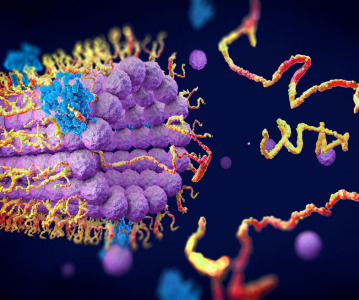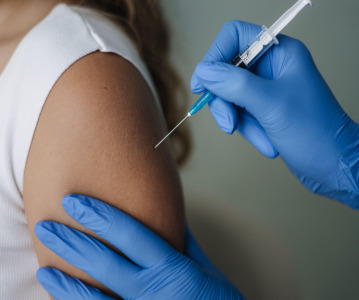Computer Model Sets New Precedent in Drug Discovery

A major challenge faced by the pharmaceutical industry has been how to rationally design and select protein molecules to create effective biologic drug therapies while reducing unintended side effects — a challenge that has largely been addressed through costly guess–and–check experiments. Researchers at the Wyss Institute for Biologically Inspired Engineering at Harvard University offer a new approach, in a study published in Biophysical Journal.
"I believe that biology is the technology of this century," said the study's senior author and Wyss Institute Core Faculty member Pamela Silver, PhD, who is also Professor in the Department of Systems Biology at Harvard Medical School. "But for that to be true in protein drug therapy, we must make drug discovery and development cheaper, faster and more predictable, with a higher potency for targets while eliminating side effects on healthy cells."
Merging expertise from computer science and synthetic drug design, the new model reveals that the drug efficacy of fusion–protein therapies depends on the geometric characteristics of a drug's molecular components. Use of the model could potentially replace the need to physically make and test new biologic drug designs, cutting down timelines and costs associated with drug development.
The engineered fusion proteins are created by attaching a specific antibody to a specific therapeutic protein by a "linker" made of rigid DNA strands. The antibody, a protein itself used as a targeting tool, is selected based on what types of cells the therapeutic portion is intended to treat. As the antibody finds its target, such as a receptor on a cancerous or otherwise infected cell, the therapeutic protein simultaneously attaches to another receptor and triggers mechanisms to disrupt the cell's behavior. The efficacy of these new types of drugs depends on how well the two components of the fusion protein work together — that is, how well they each attach to their intended receptors at the same time.
The computational model reveals that the length of the DNA linker used to connect the parts of the fusion protein influences how successfully both components are able to reach their independent receptors, empowering researchers to rationally design linker lengths that will translate into the most effective results.
What's more, the model also shows that by altering the binding strength of the therapeutic protein component, drug side effects could be further reduced. The reduced binding makes it harder for the drug to attach to cell receptors that are on the wrong cells, eliminating unintended interactions with healthy cells that share the same receptors.
"This new model helps to rationalize biologic drug discovery," said the study's lead author Avi Robinson–Mosher, a Wyss Institute postdoctoral fellow. "It is our vision that one day, it may be possible to perform in silico drug prospecting by using a computational model to survey a database of active proteins and targeting elements with a reasonable expectation of experimental success." The Wyss Institute team's model can successfully predict how linker length, drug concentration, protein signaling strength, and geometric design can impact the efficacy of a fusion protein drug, setting a new precedent in using computer simulation to potentially eliminate poor drug candidates immediately.
The team plans to expand the variety of drug designs the model can analyse, in the hope of creating a universal computational model that can be used as a primary investigatory tool in biologic drug development, eliminating physical assembly and experimentation as the go–to proving ground for new drug variants.
"This targeted new approach, which combines the elegance of computational design with the power of synthetic biology, offers a new way to shorten the timeline and decrease the costs involved with drug development," said Wyss Institute Founding Director Don Ingber, MD, PhD, who is the Judah Folkman Professor of Vascular Biology at Harvard Medical School and Boston Children's Hospital, and Professor of Bioengineering at the Harvard School of Engineering and Applied Sciences. "But what's more exciting, is that it does this by providing a way to independently ramp up drug efficacy while tuning out toxicities, something that is not possible today."
Related News
-
News A Day in the Life of a Start-Up Founder and CEO
At CPHI we work to support Start-Up companies in the pharmaceutical industry and recognise the expertise and innovative angles they bring to the field. Through our Start-Up Programme we have gotten to know some of these leaders, and in this Day in the ... -
News Biopharmaceutical manufacturing boost part of new UK government budget
In their national budget announced by the UK Labour Party, biopharmaceutical production and manufacturing are set to receive a significant boost in capital grants through the Life Sciences Innovative Manufacturing Fund (LSIMF). -
News CPHI Podcast Series: The power of proteins in antibody drug development
In the latest episode of the CPHI Podcast Series, Lucy Chard is joined by Thomas Cornell from Abzena to discuss protein engineering for drug design and development. -
News Amgen sues Samsung biologics unit over biosimilar for bone disease
Samsung Bioepis, the biologics unit of Samsung, has been issued a lawsuit brought forth by Amgen over proposed biosimilars of Amgen’s bone drugs Prolia and Xgeva. -
News CPHI Podcast Series: Why we need to consider women in clinical trials
The latest episode of the CPHI Podcast Series with Lucy Chard covers women's health, specifically women's representation in clinical trials, the associated bias, and the impacts on health for this population. -
News US FDA does not approve MDMA therapy for PTSD, requests more data
The MDMA-based therapeutic developed by Lykos Therapeutics, a California-based Public Benefit Corporation (PBC), has been reviewed and unapproved by the US FDA. The regulator has requested additional phase III trial data for further safety and efficacy... -
News Novartis and Viatris latest facing lawsuit over HeLa cell misuse
Global pharmaceutical companies Novartis and Viatris are the latest hit with a lawsuit claim pertaining to alleged misuse of the ‘HeLa’ cell line from the estate of woman whose cancerous tissue cells were taken without consent. -
News Sanofi invests billions into Frankfurt insulin production site
French pharmaceutical company Sanofi have announced an investment of EUR1.3 billion at their existing BioCampus site in Frankfurt am Main for the expansion of insulin production.
Position your company at the heart of the global Pharma industry with a CPHI Online membership
-
Your products and solutions visible to thousands of visitors within the largest Pharma marketplace
-
Generate high-quality, engaged leads for your business, all year round
-
Promote your business as the industry’s thought-leader by hosting your reports, brochures and videos within your profile
-
Your company’s profile boosted at all participating CPHI events
-
An easy-to-use platform with a detailed dashboard showing your leads and performance



.png)

.png)
.png)
.png)